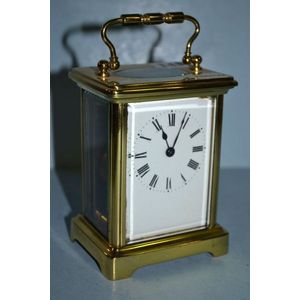French Brass Carriage Clock with Roman Numeral Dial
You must be a subscriber, and be logged in to view price and dealer details.
Subscribe Now to view actual auction price for this item
When you subscribe, you have the option of setting the currency in which to display prices to $Au, $US, $NZ or Stg.
- Lever Escapement - A lever escapement is a type of escapement mechanism used in mechanical clocks and watches to regulate the timekeeping of the movement. It was invented by British clockmaker Thomas Mudge in the 18th century and is now widely used in modern mechanical timepieces.
The lever escapement consists of three main parts: the escape wheel, the pallet fork, and the lever. The escape wheel is a wheel with teeth that is driven by the clock or watch's main spring or weight. The pallet fork is a two-pronged component that is positioned so that it can engage with the teeth of the escape wheel, and the lever is a small, L-shaped component that is attached to the pallet fork.
When the escape wheel turns, one of its teeth pushes against one of the pallet fork's prongs, causing the fork to pivot. As the pallet fork pivots, it releases the tooth and engages with the next tooth on the opposite side of the escape wheel. At the same time, the lever, which is connected to the pallet fork, rocks back and forth, allowing the escape wheel to turn at a regulated rate.
The lever escapement is prized for its accuracy and reliability and is commonly used in high-end mechanical watches. It allows for precise timekeeping by ensuring that the movement of the watch or clock is regulated and consistent, and its compact size makes it an ideal choice for use in small, portable timepieces. - Timepiece - In today's usage, the word "clock" is the name given to any instrument used for measuring time, but the word clock is derived from the Celtic word meaning "bell", and traditionally a clock without a bell or chime was known as a timepiece.
This item has been included into following indexes:
- clocks, carriage
Visually similar items

A French brass corniche cased carriage clock, with alarm, 13 cm high

A late 19th century French brass carriage clock, with bevelled glass panels, and repeating multiple strike movement. The works marked patent Surety roller. Late nineteenth century. (with key) height 18 cm.

A French brass carriage clock, of typical form and in working order, having a white enamel dial with Roman numerals and minute markings, with a visible mechanism through four panes of bevelled glass; marked 'Made in France' verso and with a double key. Hei

